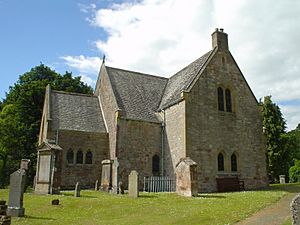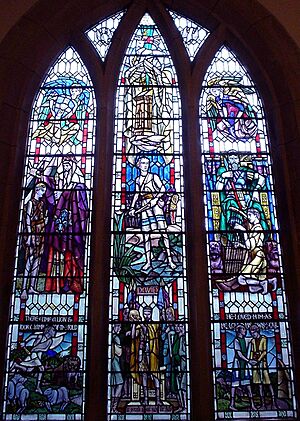Humbie Parish Church facts for kids
Quick facts for kids Humbie Parish Church |
|
|---|---|

Humbie Church from the north
|
|
| 55°51′49″N 2°51′47″W / 55.8635°N 2.8630°W | |
| Denomination | Church of Scotland |
| Churchmanship | Reformed; presbyterian |
| Administration | |
| Parish | Humbie |
| Presbytery | Lothian |
Humbie Parish Church is a church located in the small village of Humbie, which is in East Lothian, Scotland. It is part of the Church of Scotland. This church is connected with other nearby parishes, including Bolton, Saltoun, and Yester.
The church building sits a little way north of the main village. It is nestled at the bottom of a small valley.
Contents
History of Humbie Church
Early Beginnings of the Church
A church has stood on this spot for a very long time. There was a church here even before the Scottish Reformation. The Reformation was a big change in Scotland's religious history.
In 1618, two older church areas, Keith Symons and Keith Hundeby, joined together. They formed the combined parishes of Keith and Humbie.
The Disruption and Church Changes
A major event happened in 1843, known as the Scottish Disruption. At that time, the minister of Humbie Parish Church and many people in the church decided to leave. They chose to worship outside instead of staying in the church building.
This was because they disagreed with a rule called "Patronage." This rule meant that a church congregation could not choose its own minister. Instead, a local powerful person, called a Laird, would choose for them. The people of Humbie wanted to choose their own minister.
After leaving, the church went through several changes. It became part of the Free Church of Scotland. Later, it joined the United Free Church. Finally, in 1929, it rejoined the Church of Scotland.
Architecture and Design of the Church
The Current Church Building
The church building you see today was built in 1800. Originally, it had a typical T-shape and faced south. Over the years, some changes were made to its design.
In 1866, a famous architect named David Bryce made some alterations. Then, in 1932, a new section called a chancel was added. At this time, the inside of the church was also turned around. This was done so that the church's main altar faced east, which is traditional for churches.
Beautiful Stained Glass Window
In 1950, the plain glass window at the east end of the church was replaced. A new, beautiful stained glass window was installed. This window was designed by Douglas Strachan. It shows different scenes from the life of King David from the Bible.
Douglas Strachan is a very well-known artist. He also designed the stained glass for the Scottish National War Memorial at Edinburgh Castle.
The Ancient Churchyard
The church is surrounded by a very old graveyard. People are still buried there today. It is described as a peaceful place, deep in the woods with a small river flowing nearby. Some of the gravestones are still readable and show dates from as far back as the 1600s.
The Broun Aisle Building
In the churchyard, there is a small building called the Broun Aisle. A local family, the Brouns, built it in 1864. It was meant to be their family's private burial place.
The Broun family used to be buried inside the church itself. However, a sign on the building explains that this aisle was built instead. This was done "in deference to the parishioners' feelings," meaning out of respect for the church members. The burial place inside the church was then closed. Today, the Broun Aisle is also closed and is used for storage.
Music in Humbie Church
For a long time, a person called a Precentor led the singing in the church. They would stand near the pulpit and lead the songs.
In 1906, a harmonium was brought into the church. This is a type of small organ. Today, the music is led by a small pipe organ. This organ came from the Norwegian Seamen's Church in Leith, Edinburgh, in 1987.
Notable People Buried Here
The churchyard is the final resting place for some interesting people:
- Sir Robert Hogg Matthew (1906-1975): He was a very important architect in the 20th century.
- George Waterston (1911-1980): He was a stationer (someone who sells paper and writing materials) and also an expert on birds.
See also


